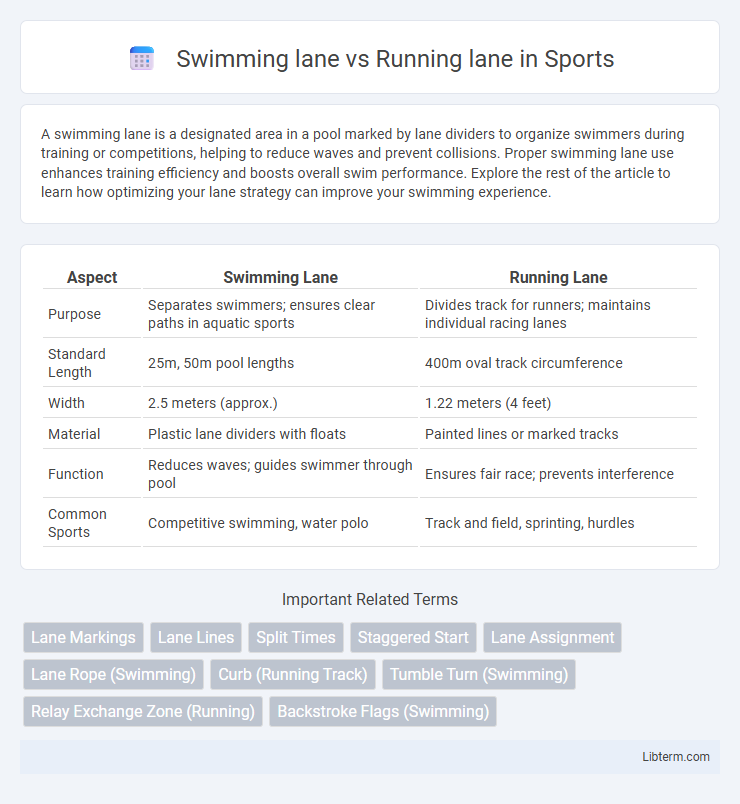A swimming lane is a designated area in a pool marked by lane dividers to organize swimmers during training or competitions, helping to reduce waves and prevent collisions. Proper swimming lane use enhances training efficiency and boosts overall swim performance. Explore the rest of the article to learn how optimizing your lane strategy can improve your swimming experience.
Table of Comparison
| Aspect | Swimming Lane | Running Lane |
|---|---|---|
| Purpose | Separates swimmers; ensures clear paths in aquatic sports | Divides track for runners; maintains individual racing lanes |
| Standard Length | 25m, 50m pool lengths | 400m oval track circumference |
| Width | 2.5 meters (approx.) | 1.22 meters (4 feet) |
| Material | Plastic lane dividers with floats | Painted lines or marked tracks |
| Function | Reduces waves; guides swimmer through pool | Ensures fair race; prevents interference |
| Common Sports | Competitive swimming, water polo | Track and field, sprinting, hurdles |
Overview: Swimming Lane vs Running Lane
Swimming lanes are designated sections in a pool, marked by floating lane dividers to separate swimmers and reduce waves for optimal swim conditions. Running lanes are track segments bordered by painted lines or barriers on a synthetic or cinder surface, designed to guide runners and ensure fair competition. Both lanes are standardized in size and markings according to international sports regulations to support athlete performance and safety.
Design and Structure Comparison
Swimming lanes are typically designed with floating lane dividers made of segmented plastic disks that reduce wave interference, ensuring smooth water flow between lanes; they are installed in pools ranging 25 to 50 meters in length and about 2.5 meters wide per lane. Running lanes feature synthetic surfaces like polyurethane or rubber tracks with precise lane markings and drainage systems, each lane generally measuring 1.22 meters wide on a 400-meter oval track; the rigid, elevated structure supports optimal traction and shock absorption for athletes. The structural contrast lies in swimming lanes facilitating fluid separation in water environments, while running lanes provide firm, non-slip surfaces engineered to enhance human biomechanics during sprinting or endurance running.
Surface Materials and Maintenance
Swimming lanes typically feature non-slip, water-resistant surfaces made of materials like textured vinyl or specialized pool tiles to reduce accidents and withstand constant moisture exposure. Running lanes are constructed with synthetic rubber or polyurethane track surfaces that provide shock absorption, durability, and enhanced traction for athletes. Maintenance for swimming lanes involves routine cleaning to prevent mold and algae buildup, while running lanes require regular inspections and resurfacing to address wear, weather damage, and maintain optimal performance conditions.
Lane Width and Markings
Swimming lanes typically measure 2.5 meters in width to accommodate competitive swimmers and reduce turbulence, with clearly marked black lines on the pool floor and contrasting colors at the end to guide turns. Running lanes are generally 1.22 meters wide in standard tracks, marked with white lines on the track surface to delineate each athlete's space for safety and fair competition. Both types of lane markings serve crucial roles in maintaining order and performance standards specific to their respective sports.
Purpose and Usage in Sports
Swimming lanes are designed to separate individual swimmers during races or training in pools, ensuring clear boundaries and minimizing wave interference for optimal performance and safety. Running lanes, marked on tracks, provide designated paths for athletes to prevent collisions and maintain fairness in sprints and distance races by regulating positioning and pacing. Both lane types serve to organize competition, enforce rules, and enhance athlete focus within their specific sporting environments.
Traffic Flow and Safety Protocols
Swimming lanes are designed to regulate swimmer movement by providing clear directional zones, minimizing collisions and enhancing safety through consistent spacing and lane markings. Running lanes prioritize pedestrian flow, often incorporating wider paths and barriers to separate runners from walkers, reducing congestion and preventing accidents. Both types of lanes implement specific safety protocols, such as directional signage and physical dividers, to optimize traffic flow and maintain orderly movement.
Speed and Performance Considerations
Swimming lanes and running lanes are designed to optimize speed and performance by minimizing resistance and distractions. Swimming lanes utilize lane ropes that reduce wave turbulence, allowing swimmers to maintain a streamlined flow and achieve faster times. Running lanes provide clear, marked paths with smooth surfaces to enhance traction and minimize energy loss, crucial for maximizing sprinting speed and endurance.
Training Techniques and Strategies
Swimming lane training emphasizes controlled strokes, breathing patterns, and intervals to improve endurance and technique efficiency, utilizing drills like butterfly sets and flip turns. Running lane workouts focus on pacing, stride mechanics, and interval training, incorporating sprints, tempo runs, and hill repeats to optimize speed and stamina. Both disciplines leverage lane-specific strategies to maximize performance by targeting sport-specific muscle groups and energy systems.
Common Challenges and Solutions
Swimming lanes often face challenges like water turbulence and lane rope displacement, which disrupt swimmers' performance and safety. Running lanes encounter issues such as track surface wear and lane encroachment that affect athletes' traction and fairness. Solutions include installing advanced lane ropes that reduce wave resistance in pools and using high-durability synthetic track materials combined with lane markings to maintain lane integrity on running tracks.
Environmental and Health Benefits
Swimming lanes contribute significantly to cardiovascular health by providing low-impact aerobic exercise that reduces joint strain and improves lung capacity. Running lanes support weight-bearing activities that enhance bone density and muscular strength while promoting endorphin release for mental well-being. Environmentally, swimming pools require substantial water and energy resources, whereas running tracks typically demand less maintenance and energy, offering a more sustainable exercise option in outdoor settings.
Swimming lane Infographic

 libterm.com
libterm.com